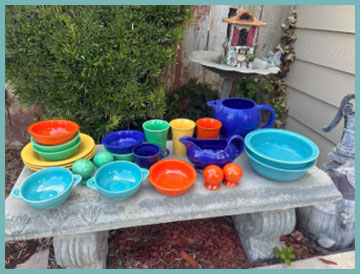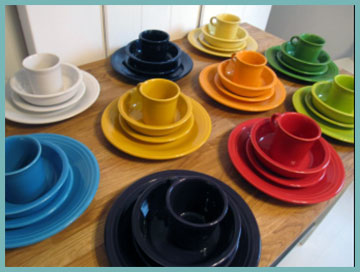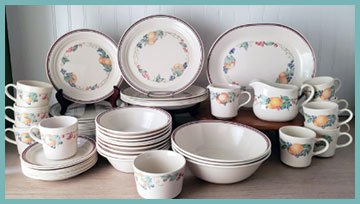I’ve always loved setting a beautiful table, but choosing the right dinnerware can feel like a high-stakes decision. Fiestaware and Corelle are two iconic brands that have won hearts for their unique styles and practicality, but which one suits your kitchen best?
In this article, I’ll share my personal journey with both, breaking down their pros and cons, and comparing their key features to help you decide. From durability to aesthetics, I’ll explore what makes each brand special, offering a clear, engaging guide to picking the perfect plates for your home.
Comparison Table: Fiestaware Vs. Corelle
| Feature | Fiestaware | Corelle |
|---|---|---|
| Material | Vitrified ceramic with glaze | Vitrelle (three-layer tempered glass) |
| Weight | Heavier, substantial feel | Lightweight, easy to handle |
| Durability | Durable, but prone to chipping | Highly chip-resistant, can shatter |
| Design | Bold, colorful Art Deco style | Minimalist, classic patterns |
| Temperature Tolerance | Oven-safe up to 350°F | Microwave-safe, not oven-safe |
| Price | Premium, $20+ per piece | Affordable, ~$16 per set |
| Made In | USA, lead-free | USA, lead-free |
| Maintenance | Dishwasher-safe, may scratch | Dishwasher-safe, easy to clean |
| Collectibility | High, with seasonal colors | Limited, focus on practicality |
My Experience With Fiestaware

When I first unboxed my Fiestaware set, I was smitten.
The cobalt blue dinner plates and turmeric bowls practically glowed under my kitchen lights, transforming my dining table into a work of art.
I chose a mix of colors—scarlet, sunflower, and white—to reflect my love for bold, eclectic style.
Setting the table for a family dinner felt like curating a gallery, and my guests couldn’t stop complimenting the vibrant look.
Using Fiestaware daily has been a joy, but it’s not without quirks. The weight of the plates gives them a premium feel, but I’ve caught myself grumbling while hauling a stack to the cupboard. I also love popping a casserole dish straight into the oven, which is a huge plus for someone who bakes often.
However, I did notice a small chip on a mug after a dishwasher mishap, which stung given the investment. Cleaning is generally easy, but I’ve had to scrub off utensil marks on my white plates, which takes extra effort.
Overall, Fiestaware makes me smile every time I open my cabinet. It’s like owning a piece of American history with a modern twist. But if you’re not ready to baby your dishes a bit or spend a premium, it might not be the perfect fit.
Read More: My Thoughts On Oneida vs. Lenox Flatware
Pros Of Fiestaware
- Vibrant Aesthetic: Fiestaware’s bold, colorful designs are a feast for the eyes. With over 35 glaze colors, from classic scarlet to seasonal hues like peony, I can mix and match to create a table that screams personality. It’s like painting your dining experience with every meal.
- Oven Versatility: Unlike many dinnerware brands, Fiestaware can go straight from the fridge to the oven (up to 350°F). I’ve baked casseroles in their bowls and served them directly, which saves time and dishes.
- Made In The USA: Knowing Fiestaware is crafted in West Virginia since 1936 gives me confidence in its quality. The lead-free, cadmium-free glaze ensures it’s safe for daily use, which is a big deal for health-conscious folks like me.
- Collectible Appeal: Fiestaware’s ever-changing color palette makes it a collector’s dream. I’ve found myself hunting for retired shades like Radioactive Red, which adds a fun, treasure-hunt vibe to owning these dishes.
- Durability For Everyday Use: The vitrified ceramic is fired at high temperatures, making it tough enough for daily meals. I’ve dropped plates on my linoleum floor, and they’ve survived without a scratch, backed by a 5-year chip resistance warranty.
- Heat Retention: These dishes hold heat well, keeping my food warm longer than glass-based options. It’s perfect for cozy dinners where I want my soup to stay hot.
- Mix-And-Match Flexibility: The ability to combine colors and patterns lets me customize my table for holidays or moods. I’ve paired cobalt mugs with sunflower plates for a vibrant summer brunch that got everyone talking.
Fiestaware’s charm lies in its ability to make every meal feel like an event. The weighty feel and bold colors elevate even a simple weeknight dinner, and the oven-safe feature is a game-changer for someone who loves to cook and serve in style. However, it’s not perfect, and I’ll get into that next.
Cons Of Fiestaware

- Higher Price Point: Fiestaware isn’t cheap. A single bistro salad plate can cost $20 or more, which adds up fast if you’re buying a full set. I had to budget carefully to expand my collection, especially for special pieces.
- Prone To Chipping: While durable, Fiestaware can chip if mishandled. I’ve noticed small nicks on a mug after it clinked against another dish in the dishwasher, which was disappointing given the price.
- Heavy Weight: These dishes are noticeably heavier than alternatives. Carrying a stack of plates to the table can feel like a workout, and it’s not ideal for households with young kids or elderly folks.
- Scratch Marks From Utensils: Over time, I’ve seen faint scratches on my lighter-colored plates from forks and knives. While Barkeepers’ Friend can help, it’s an extra maintenance step I didn’t expect.
- Awkward Stacking: The bowls, especially, don’t stack as neatly as I’d like. They take up more cabinet space, which is a hassle in my small kitchen where every inch counts.
- Limited Dishwasher Fit: Some pieces, like the larger bowls, don’t fit well in modern dishwashers with tight tines. I’ve had to rearrange my dishwasher carefully to avoid overcrowding.
- Crazing Potential: Over years of use, the glaze can develop fine cracks (crazing), especially if exposed to extreme temperature changes. I haven’t seen this yet, but it’s a concern for long-term use.
The cons of Fiestaware mostly come down to practicality. While it’s stunning and versatile, the weight, cost, and occasional chipping make it less forgiving for clumsy hands or tight budgets. Still, its charm keeps me coming back.
My Experience With Corelle

I’ve been a Corelle user for years, and it’s been a workhorse in my kitchen.
My white set with a subtle floral pattern is simple yet elegant, blending into any dining setup without stealing the show.
The lightweight plates are a godsend when I’m juggling a toddler, groceries, and dinner prep.
I can stack a dozen plates in one hand and still have room in my cupboard for everything else.
The durability is unreal—I’ve dropped plates countless times, and they rarely break. But when one did shatter, it was a mess, with tiny glass pieces everywhere. I love that they’re microwave-safe, making reheating a breeze, but I miss the oven versatility of other brands.
Cleaning is effortless, and the price let me buy a full set without stress. Corelle feels like the practical choice for my chaotic life, but I sometimes crave the bold personality of other options.
Pros Of Corelle
- Incredible Durability: Corelle’s Vitrelle glass is a marvel. I’ve dropped plates on my tile floor, and they’ve bounced back unscathed. It’s perfect for busy households where accidents happen.
- Lightweight Design: These dishes are feather-light, making them a breeze to handle. I can carry a stack of eight plates with one hand, which is a lifesaver during big gatherings.
- Affordable Price: Corelle is budget-friendly, with sets starting at $16 for soup bowls. I built a full collection without breaking the bank, which left room for other kitchen upgrades.
- Space-Saving Stacking: The thin design means Corelle stacks neatly, taking up minimal cabinet space. In my small kitchen, this is a huge win, leaving room for my endless gadgets.
- Microwave-Safe: I reheat leftovers in Corelle plates all the time, and they handle the microwave like champs. No worrying about chemicals leaching into my food, either.
- Easy Maintenance: Corelle is dishwasher-safe and resists scratches and stains. I’ve never had to scrub hard to keep them looking new, even after years of use.
- Timeless Patterns: While simpler than Fiestaware, Corelle’s classic designs, like white with subtle florals, fit any dining style. They’re understated but elegant, perfect for everyday meals.
Corelle’s practicality is its superpower. It’s the dinnerware equivalent of a reliable friend—always there, no fuss, and ready for anything. It’s ideal for families or anyone who values function over flash.
Cons Of Corelle
- Shattering Risk: While chip-resistant, Corelle can shatter into tiny, sharp pieces if it does break. I’ve swept up a million shards after a bowl hit my floor at the wrong angle, and it was a nightmare.
- Not Oven-Safe: Unlike Fiestaware, Corelle can’t handle the oven. I’ve had to transfer dishes to other cookware for baking, which adds an extra step.
- Limited Aesthetic Appeal: Corelle’s minimalist designs are nice but lack the wow factor of Fiestaware. I sometimes wish for more color to spice up my table.
- Heat Transfer: These plates sit flat and transfer heat directly to surfaces. I’ve had to use placemats to protect my wooden table, which I didn’t anticipate.
- Fragile Edges: Though rare, the edges can chip if banged hard. I’ve seen a tiny nick on a plate after it hit a sink edge, which was frustrating.
- Less Substantial Feel: The lightweight design is great for handling but feels less luxurious. My husband prefers the heft of heavier dishes for formal dinners.
- Pattern Wear: Some painted-on patterns can fade over time in the dishwasher. My older set shows slight wear, which makes it look less polished.
Corelle’s cons are mostly about trade-offs for its affordability and lightness. It’s practical but lacks the flair and versatility of Fiestaware, which might matter if you love a statement table.
Comparison With Other Brands
- Fiestaware Vs. Pfaltzgraff: Pfaltzgraff offers a middle ground in price, often half the cost of Fiestaware. Its stoneware is durable but chips more easily, and I’ve noticed utensil marks on their glaze. Fiestaware’s vibrant colors and oven-safe feature give it an edge for style and versatility, but Pfaltzgraff’s patterns feel more traditional.
- Corelle Vs. Pfaltzgraff: Corelle wins for lightweight durability and affordability. Pfaltzgraff’s heavier stoneware feels more substantial but takes up more space and can chip. I prefer Corelle for daily use, but Pfaltzgraff’s classic designs are great for formal settings.
- Fiestaware Vs. Longaberger: Longaberger pottery is comparable to Fiestaware in heft and durability, but it’s pricier and less colorful. I find Fiestaware’s mix-and-match colors more fun, while Longaberger feels more upscale for special occasions.
- Corelle Vs. IKEA Tempered Glass: IKEA’s Oftast line is similar to Corelle, with tempered glass at a lower price. However, Corelle’s Vitrelle is more refined, with better stacking and durability. I’ve used IKEA plates, but they feel less polished than Corelle.
- Fiestaware Vs. Noritake: Noritake’s china is elegant but fragile compared to Fiestaware’s robust ceramic. Fiestaware’s casual, colorful vibe suits my everyday needs better, while Noritake is better for formal dining.
- Corelle Vs. Melamine: Melamine is lightweight and colorful but can’t be microwaved safely due to chemical leaching risks. Corelle’s Vitrelle is a safer, more durable choice for daily use, which I appreciate as a health-conscious cook.
Comparing these brands helped me appreciate Fiestaware’s flair and Corelle’s practicality. Your choice depends on whether you prioritize style or function, but both hold their own against competitors.
Read More: My Thoughts On Williams-Sonoma Vs. Sur La Table
Frequently Asked Questions (FAQ)
Corelle is fantastic for durability, but some stop using it because it can shatter into tiny, sharp pieces when dropped, making cleanup a hassle. Its minimalist designs may also feel too plain for those craving bold aesthetics.
Yes, Fiestaware is high quality, made from vitrified ceramic in the USA with lead-free glazes. Its durability and 5-year chip resistance warranty make it a reliable choice, though it’s pricier.
Corelle plates are made from Vitrelle, a three-layer tempered glass that’s lightweight, chip-resistant, and microwave-safe. Their slim design saves space, and they’re affordable for everyday use.
Fiestaware is durable but can chip if mishandled, especially in dishwashers or against hard surfaces. While not as chip-prone as some ceramics, it requires more care than Corelle.
Conclusion: For Fiestaware And Corelle
Choosing between Fiestaware and Corelle comes down to your lifestyle and priorities. If you love vibrant, collectible dishes that double as oven-safe cookware, Fiestaware’s bold charm is for you, despite its higher cost and weight. If you need affordable, lightweight, and nearly indestructible plates for daily chaos, Corelle’s practicality is unbeatable, even if it lacks flair. I’ve loved using both, but your perfect pick depends on whether you value style or simplicity. Weigh your needs, and you’ll find the right fit for your table.
